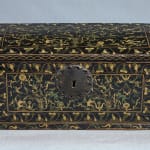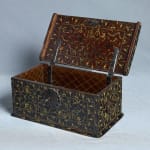BARNIZ DE PASTO LACQUERED, COLONIAL CHEST
Lacquered and polychrome wood
Width: 34.5 cm
Depth: 18 cm
Provenance
Private Collection.
This box of colonial origin, more precisely as its name and technique indicate, was made in the Pasto region, nowadays part of Colombia. It has a rectangular format, in the form of a chest, with a slightly bulged lid. It consists of an iron lock and two handles for easy transport. A dense decoration on a black background in its delicately painted exterior fills practically all the available space both in the lid and in the body of the box. This decoration is composed of curly plant stems among which exotic Andean animals are arranged, small monkeys that jump between the branches and birds. The green and yellow tones of the paint stand out against the dark background. These shades and motifs are typical of the decoration of boxes, trunks and bunkers of colonial times in Colombia. The box has also been painted using a technique that also helps us specify its origin. The material known as Varnish of Pasto has been used, a lacquer made from Mopa Mopa resin, typical of the Pasto area, Colombia, although also used in Peru and Ecuador from colonial times to the present. This lacquer provides a glossy and water resistant finish, which was often used to mimic the appearance of Asian lacquer.



